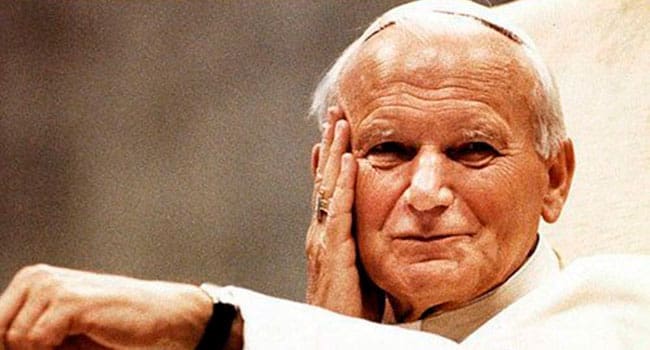 There are many dark pages in the history of the 20th century, notably the tens of millions of deaths cased by Adolf Hitler and Josef Stalin. Caught between the regimes of these cruel dictators was the Poland where Karol Wojtyla came of age.
There are many dark pages in the history of the 20th century, notably the tens of millions of deaths cased by Adolf Hitler and Josef Stalin. Caught between the regimes of these cruel dictators was the Poland where Karol Wojtyla came of age.
The leaders of Nazism and Soviet communism tried to convince people that they were part of a great cause. The problem was that neither respected the dignity of individuals.
Wojtyla, however, believed that while we can all work together for a common cause, each of us is not only significant, we’re sacred beings and we’re loved.
After Stalinist Russia took control of Poland and much of Eastern Europe after the Second World War, Wojtyla studied and then taught the philosophy that ultimately led to the downfall of communism. The Catholic Church in Poland became the greatest voice in opposing the state and Wojtyla, seen as open to dialogue, rose through the ranks of this institution.
In 1978, Wojtila was named Pope John Paul II. Few outside of Poland knew who he was or what he had accomplished, but he immediately began using his global influence to bring down the Iron Curtain.
His message was quite simple: “Be not afraid.” He told people that they’re loved and sacred. He told them to embrace their dignity as humans, and to stand together for justice and freedom.
It didn’t take long for workers to organize in his native Poland. The Solidarity movement became a powerful force. The government first tried to crush the movement through violence, arrests and intimidation. But with the world watching, their efforts only served to strengthen the resolve of the people. Wojtyla embraced his identity as a Pole and as an Eastern European, and the ideal of freedom spread.
By the end of the 1980s, the Iron Curtain had collapsed and the world was changed forever.
By studying the thoughts of Wojtyla, you see what inspired and motivated the person who led the revolution against a cruel dictatorship without ever speaking of violence.
As with all people who accomplish great things, Wojtyla knew he had a mission. This was expressed in a discussion with a friend while recovering from an assassination attempt in 1981. “There is nothing more beautiful than to be a tool in the hands of God,” he said.
In 1983, the Pope actually visited the jail cell of the man who tried to kill him and forgave him. There were other attempts on his life but he moved forward without fear. Millions of people took inspiration from him, especially in Eastern Europe, and did the same.
While no leader and no institution is perfect, John Paul II was the right leader for his time. No one but an Eastern European in a position of global leadership could have led a movement to overthrow the powerful communist regime.
It’s significant to note the similarities between the peaceful movements that overcame oppressive governments in the 20th century and brought about lasting change. Mahatma Gandhi, Martin Luther King Jr. and Nelson Mandela all had clear visions, and offered messages of personal empowerment, forgiveness, courage, acceptance and love.
No force on earth is more powerful than a movement that embraces these truths. It may take time but triumph is inevitable.
It’s important to see beyond today’s issues and apply what’s worked in the past. The words of John Paul II still ring clearly: “Be not afraid.”
Gerry Chidiac is an award-winning high school teacher specializing in languages, genocide studies and work with at-risk students.
The views, opinions and positions expressed by columnists and contributors are the author’s alone. They do not inherently or expressly reflect the views, opinions and/or positions of our publication.


